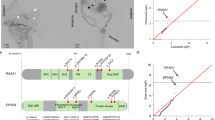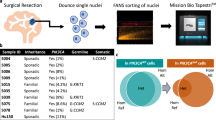Abstract
Recent studies have shown that the PI3K signaling pathway plays an important role in the pathogenesis of slow-flow vascular malformations (SFVMs). Analysis of genetic mutations has advanced our understanding of the mechanisms involved in SFVM pathogenesis and may identify new therapeutic targets. We screened for somatic variants in a cohort of patients with SFVMs using targeted next-generation sequencing. Targeted next-generation sequencing of 29 candidate genes associated with vascular anomalies or with the PI3K signaling pathway was performed on affected tissues from patients with SFVMs. Fifty-nine patients with SFVMs (venous malformations n = 21, lymphatic malformations n = 27, lymphatic venous malformations n = 1, and Klippel–Trenaunay syndrome n = 10) were included in the study. TEK and PIK3CA were the most commonly mutated genes in the study. We detected eight TEK pathogenic variants in 10 samples (16.9%) and three PIK3CA pathogenic variants in 28 samples (47.5%). In total, 37 of 59 patients (62.7%) with SFVMs harbored pathogenic variants in these three genes involved in the PI3K signaling pathway. Inhibitors of this pathway may prove useful as molecular targeted therapies for SFVMs.
This is a preview of subscription content, access via your institution
Access options
Subscribe to this journal
Receive 12 print issues and online access
$259.00 per year
only $21.58 per issue
Buy this article
- Purchase on Springer Link
- Instant access to full article PDF
Prices may be subject to local taxes which are calculated during checkout


Similar content being viewed by others
References
Steiner JE, Drolet BA. Classification of vascular anomalies: An update. Semin Interv Radio. 2017;34:225–32.
Rodríguez-Mañero M, Aguado L, Redondo P. Pulmonary arterial hypertension in patients with slow-flow vascular malformations. Arch Dermatol. 2010;146:1347–52.
Hammer J, Seront E, Duez S, et al. Sirolimus is efficacious in treatment for extensive and/or complex slow-flow vascular malformations: a monocentric prospective phase II study. Orphanet J Rare Dis. 2018;13:191.
Nguyen HL, Boon LM, Vikkula M. Vascular anomalies caused by abnormal signaling within endothelial cells: Targets for novel therapies. Semin Interv Radio. 2017;34:233–8.
Paolacci S, Mattassi RE, Marceddu G, et al. Somatic variant analysis identifies targets for tailored therapies in patients with vascular malformations. J Clin Med. 2020;9:E3387.
Siegel DH, Cottrell CE, Streicher JL, et al. Analyzing the genetic spectrum of vascular anomalies with overgrowth via cancer genomics. J Invest Dermatol. 2018;138:957–67.
Tee AR, Blenis J. mTOR, translational control and human disease. Semin Cell Dev Biol. 2005;16:29–37.
Castel P, Carmona FJ, Grego-Bessa J, et al. Somatic PIK3CA mutations as a driver of sporadic venous malformations. Sci Transl Med. 2016;8:332ra42.
Nguyen HL, Boon LM, Vikkula M. Genetics of vascular anomalies. Semin Pediatr Surg. 2020;29:150967.
McDonell LM, Mirzaa GM, Alcantara D, et al. Mutations in STAMBP, encoding a deubiquitinating enzyme, cause microcephaly-capillary malformation syndrome. Nat Genet. 2013;45:556–62.
Cingolani P, Platts A, Wang Le L, et al. A program for annotating and predicting the effects of single nucleotide polymorphisms, SnpEff: SNPs in the genome of Drosophila melanogaster strain w1118; iso-2; iso-3. Fly (Austin). 2012;6:80–92.
Cingolani P, Patel VM, Coon M, et al. Using Drosophila melanogaster as a model for genotoxic chemical mutational studies with a new program, SnpSift. Front Genet. 2012;3:35.
Landrum MJ, Lee JM, Benson M, et al. ClinVar: public archive of interpretations of clinically relevant variants. Nucleic Acids Res. 2016;44:D862–D868.
Liu X, Wu C, Li C, et al. dbNSFP v3.0: A one-stop database of functional predictions and annotations for human nonsynonymous and splice-site SNVs. Hum Mutat. 2016;37:235–41.
Robinson JT, Thorvaldsdóttir H, Winckler W, et al. Integrative genomics viewer. Nat Biotechnol. 2011;29:24–26.
Li Q, Wang K. InterVar: Clinical interpretation of genetic variants by the 2015 ACMG-AMP guidelines. Am J Hum Genet. 2017;100:267–80.
Rentzsch P, Witten D, Cooper GM, et al. CADD: predicting the deleteriousness of variants throughout the human genome. Nucleic Acids Res. 2019;47:D886–D894.
Chirita-Emandi A, Andreescu N, Zimbru CG, et al. Challenges in reporting pathogenic/potentially pathogenic variants in 94 cancer predisposing genes - in pediatric patients screened with NGS panels. Sci Rep. 2020;10:223.
Mattassi R, Manara E, Colombo PG, et al. Variant discovery in patients with Mendelian vascular anomalies by next-generation sequencing and their use in patient clinical management. J Vasc Surg. 2018;67:922–32.
1000 Genomes Project Consortium, Auton A, Brooks LD, Durbin RM, et al. A global reference for human genetic variation. Nature. 2015;526:68–74.
Ng PC, Henikoff S. SIFT: Predicting amino acid changes that affect protein function. Nucleic Acids Res. 2003;31:3812–4.
Adzhubei I, Jordan DM, Sunyaev SR Predicting functional effect of human missense mutations using PolyPhen-2. Curr Protoc Hum Genet. 2013; Chapter 7:Unit7.20.
Schwarz JM, Rödelsperger C, Schuelke M, et al. MutationTaster evaluates disease-causing potential of sequence alterations. Nat Methods. 2010;7:575–6.
Karczewski KJ, Francioli LC, Tiao G, et al. The mutational constraint spectrum quantified from variation in 141,456 humans. Nature. 2020;581:434–43.
Forbes SA, Bindal N, Bamford S, et al. COSMIC: mining complete cancer genomes in the Catalogue of Somatic Mutations in Cancer. Nucleic Acids Res. 2011;39:D945–D950.
Limaye N, Kangas J, Mendola A, et al. Somatic activating PIK3CA mutations cause venous malformation. Am J Hum Genet. 2015;97:914–21.
Soblet J, Limaye N, Uebelhoer M, et al. Variable somatic TIE2 mutations in half of sporadic venous malformations. Mol Syndromol. 2013;4:179–83.
Limaye N, Wouters V, Uebelhoer M, et al. Somatic mutations in angiopoietin receptor gene TEK cause solitary and multiple sporadic venous malformations. Nat Genet. 2009;41:118–24.
Soblet J, Kangas J, Nätynki M, et al. Blue Rubber Bleb nevus (BRBN) syndrome is caused by somatic TEK (TIE2) mutations. J Invest Dermatol. 2017;137:207–16.
Ten Broek RW, Eijkelenboom A, van der Vleuten CJM, et al. Comprehensive molecular and clinicopathological analysis of vascular malformations: A study of 319 cases. Genes Chromosomes Cancer. 2019;58:541–50.
Queisser A, Seront E, Boon LM, et al. Genetic basis and therapies for vascular anomalies. Circ Res. 2021;129:155–73.
Nätynki M, Kangas J, Miinalainen I, et al. Common and specific effects of TIE2 mutations causing venous malformations. Hum Mol Genet. 2015;24:6374–89.
Goines J, Li X, Cai Y, et al. A xenograft model for venous malformation. Angiogenesis. 2018;21:725–35.
Castillo SD, Baselga E, Graupera M. PIK3CA mutations in vascular malformations. Curr Opin Hematol. 2019;26:170–8.
Souma T, Tompson SW, Thomson BR, et al. Angiopoietin receptor TEK mutations underlie primary congenital glaucoma with variable expressivity. J Clin Invest. 2016;126:2575–87.
Vikkula M, Boon LM, Carraway KL 3rd, et al. Vascular dysmorphogenesis caused by an activating mutation in the receptor tyrosine kinase TIE2. Cell. 1996;87:1181–90.
Defnet AM, Bagrodia N, Hernandez SL, et al. Pediatric lymphatic malformations: Evolving understanding and therapeutic options. Pediatr Surg Int. 2016;32:425–33.
Luks VL, Kamitaki N, Vivero MP, et al. Lymphatic and other vascular malformative/overgrowth disorders are caused by somatic mutations in PIK3CA. J Pediatr. 2015;166:1048–.e1–e5.
Blesinger H, Kaulfuß S, Aung T, et al. PIK3CA mutations are specifically localized to lymphatic endothelial cells of lymphatic malformations. PLoS One. 2018;13:e0200343.
Zenner K, Cheng CV, Jensen DM, et al. Genotype correlates with clinical severity in PIK3CA-associated lymphatic malformations. JCI Insight. 2019;4:e129884.
Wooderchak-Donahue WL, Johnson P, McDonald J, et al. Expanding the clinical and molecular findings in RASA1 capillary malformation-arteriovenous malformation. Eur J Hum Genet. 2018;26:1521–36.
Banzic I, Brankovic M, Maksimović Ž, et al. Parkes Weber syndrome-Diagnostic and management paradigms: A systematic review. Phlebology. 2017;32:371–83.
Sharma M, Mallya V, Khurana N, et al. Lymphovascular malformation—A report of two cases. J Clin Diagn Res. 2017;11:ED03–ED04.
Cohen MM Jr. Klippel-Trenaunay syndrome. Am J Med Genet. 2000;93:171–5.
Ozeki M, Nozawa A, Yasue S, et al. The impact of sirolimus therapy on lesion size, clinical symptoms, and quality of life of patients with lymphatic anomalies. Orphanet J Rare Dis. 2019;14:141.
Kangas J, Nätynki M, Eklund L. Development of molecular therapies for venous malformations. Basic Clin Pharm Toxicol. 2018;123:6–19.
Zollino M, Ranieri C, Grossi V, et al. Germline pathogenic variant in PIK3CA leading to symmetrical overgrowth with marked macrocephaly and mild global developmental delay. Mol Genet Genom Med. 2019;7:e845.
Acknowledgements
We are grateful to the patients and their families for their invaluable contributions to this study. We thank Drs. Shiho Yasue, Saori Endo, and Mariko Seishima of Gifu University for their assistance with data analysis. We thank Dr. Koki Nagai of Tohoku University for providing technical assistance with TA cloning analysis. We also thank the Department of Pediatrics at Gifu University for their contribution. We thank Dr. Laurence M. Boon of Saint Luc University Hospital, Dr. Miikka Vikkula of University of Louvain, and Dr. Hiroshi Nagabukuro and Dr. Akira Tanaka of ARTham Therapeutics for helpful discussions and suggestions. We also thank Yuichi Arakawa and Kuniko Kikuchi of Axcelead Drug Discovery Partners, Inc., for technical assistance, and Anne M. O’Rourke, PhD, from Edanz Group (https://en-author-services.edanz.com/ac) for editing a draft of this manuscript.
Funding
This study was supported in part by a Clinical Research-Clinical Trial Promotion Research Project grant (19lk0201089h0001) from the Japan Agency for Medical Research and Development and by funding from ARTham Therapeutics, Inc.
Author information
Authors and Affiliations
Contributions
AN, AF, SY, SS, AK, FS, NA, KK, KS, and MO conceived and designed the study. KS performed the next-generation sequencing and AN, KK, KS, HO, YA, and MO interpreted the data. AN and MO wrote the manuscript. All authors read and approved the final manuscript.
Corresponding author
Ethics declarations
Competing interests
Some of the authors declared Financial and Non-Financial Relationships and Activities, and Conflicts of Interest regarding this manuscript as indicated in the supplementary materials.
Ethics approval
This study was conducted in accordance with the ethical principles of the Declaration of Helsinki and Good Clinical Practice guidelines and approved by the ethics committee or institutional review board of each institution.
Additional information
Publisher’s note Springer Nature remains neutral with regard to jurisdictional claims in published maps and institutional affiliations.
Supplementary information
Rights and permissions
Springer Nature or its licensor holds exclusive rights to this article under a publishing agreement with the author(s) or other rightsholder(s); author self-archiving of the accepted manuscript version of this article is solely governed by the terms of such publishing agreement and applicable law.
About this article
Cite this article
Nozawa, A., Fujino, A., Yuzuriha, S. et al. Comprehensive targeted next-generation sequencing in patients with slow-flow vascular malformations. J Hum Genet 67, 721–728 (2022). https://doi.org/10.1038/s10038-022-01081-6
Received:
Revised:
Accepted:
Published:
Issue Date:
DOI: https://doi.org/10.1038/s10038-022-01081-6
This article is cited by
-
Targeted next-generation sequencing for detection of PIK3CA mutations in archival tissues from patients with Klippel–Trenaunay syndrome in an Asian population
Orphanet Journal of Rare Diseases (2023)



